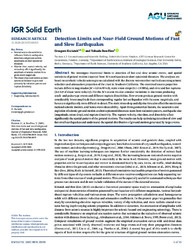Detection Limits and Near-Field Ground Motions of Fast and Slow Earthquakes
DOI: https://doi.org/10.1029/2019JB018935
Persistent URL: http://resolver.sub.uni-goettingen.de/purl?gldocs-11858/9340
Persistent URL: http://resolver.sub.uni-goettingen.de/purl?gldocs-11858/9340
Kwiatek, Grzegorz; Ben-Zion, Yehuda, 2020: Detection Limits and Near-Field Ground Motions of Fast and Slow Earthquakes. In: Journal of Geophysical Research: Solid Earth, Band 125, 7, DOI: 10.1029/2019JB018935.
 |
Dokument öffnen: |
We investigate theoretical limits to detection of fast and slow seismic events, and spatial variations of ground motion expected from M 6 earthquakes at short epicentral distances. The analyses are based on synthetic velocity seismograms calculated with the discrete wavenumber method assuming seismic velocities and attenuation properties of the crust in Southern California. The examined source properties include different magnitudes (M −1.0 to M 6.0), static stress drops (0.1–10 MPa), and slow and fast ruptures (0.1–0.9 of shear wave velocity). For the M 6 events we also consider variations in rise times producing crack- and pulse-type events and different rupture directivities. Slow events produce ground motion with considerably lower amplitude than corresponding regular fast earthquakes with the same magnitude, and hence are significantly more difficult to detect. The static stress drop and slip rise time also affect the maximum radiated seismic motion, and hence event detectability. Apart from geometrical factors, the saturation and depletion of seismic ground motion at short epicentral distances stem from radiation pattern, earthquake size (magnitude, stress drop), and rupture directivity. The rupture velocity, rise time, and directivity affect significantly the spatial pattern of the ground motions. The results can help optimizing detection of slow and fast small earthquakes and understand the spatial distribution of ground motion generated by large events.
Statistik:
ZugriffsstatistikSammlung:
This is an open access article under the terms of the Creative Commons Attribution License, which permits use, distribution and reproduction in any medium, provided the original work is properly cited.

